401081: National Health Reform Agreement Analysis and Recommendations
VerifiedAdded on 2023/06/03
|11
|2436
|278
Report
AI Summary
This report provides a comprehensive analysis of the National Health Reform Agreement in Australia. It begins with an executive summary highlighting the objectives, principles, implementation process, and the government's role in the reform. The report then delves into the agreement's objectives, which include improving patient access to healthcare, enhancing public hospital efficiency through activity-based funding, and ensuring sustainable funding. It details the implementation steps, including the roles of the Council of Australian Governments (COAG) and the Treasury, and emphasizes the coordination between hospitals and primary healthcare providers. The report also examines the government's role in funding allocation across various healthcare sectors, and discusses the challenges, such as difficulties in providing services to remote communities and the need for improved clinical governance. Finally, it concludes with recommendations to enhance transparency, improve clinical standards, and ensure robust needs assessments for effective implementation of the health reforms.
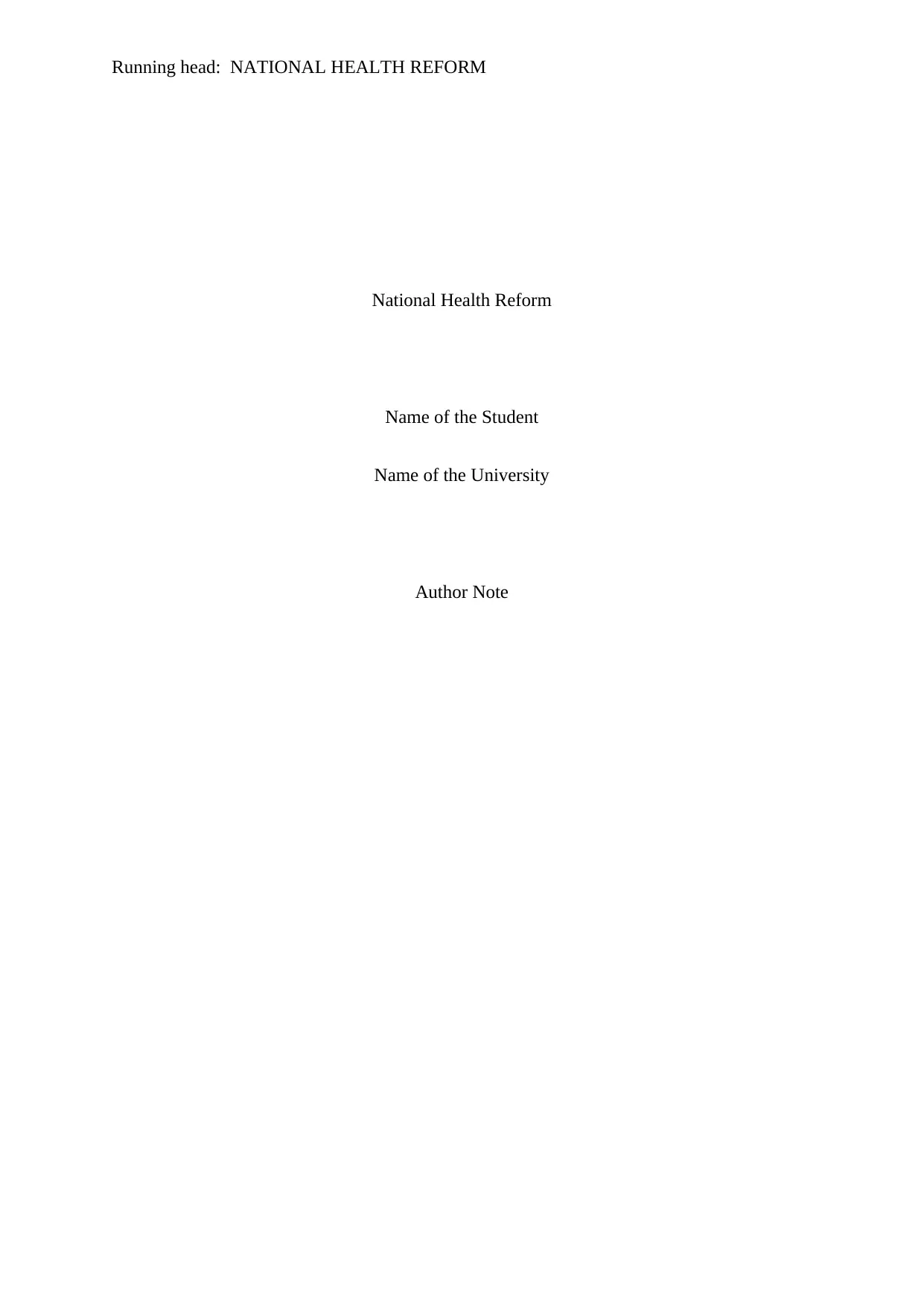
Running head: NATIONAL HEALTH REFORM
National Health Reform
Name of the Student
Name of the University
Author Note
National Health Reform
Name of the Student
Name of the University
Author Note
Paraphrase This Document
Need a fresh take? Get an instant paraphrase of this document with our AI Paraphraser
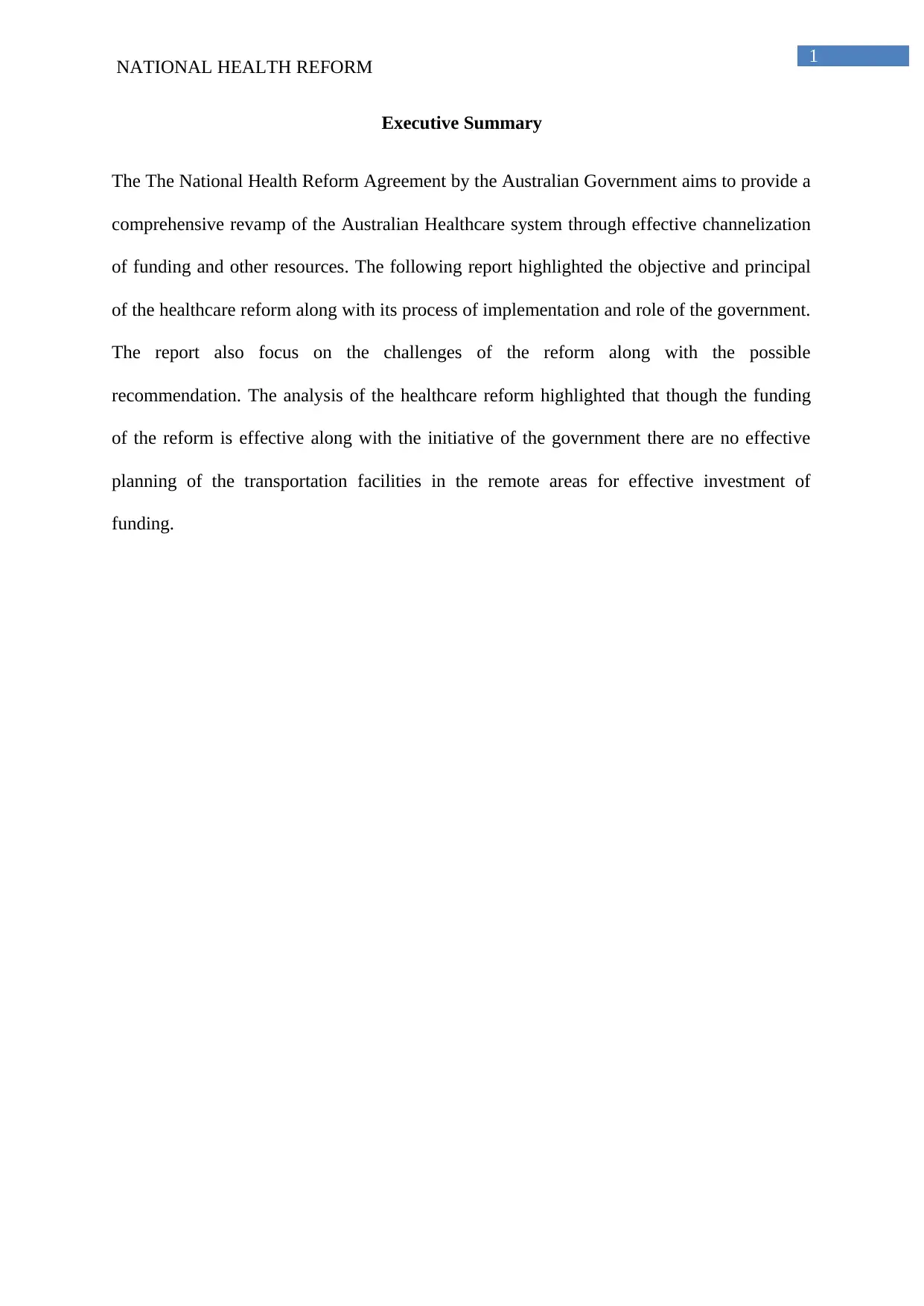
1
NATIONAL HEALTH REFORM
Executive Summary
The The National Health Reform Agreement by the Australian Government aims to provide a
comprehensive revamp of the Australian Healthcare system through effective channelization
of funding and other resources. The following report highlighted the objective and principal
of the healthcare reform along with its process of implementation and role of the government.
The report also focus on the challenges of the reform along with the possible
recommendation. The analysis of the healthcare reform highlighted that though the funding
of the reform is effective along with the initiative of the government there are no effective
planning of the transportation facilities in the remote areas for effective investment of
funding.
NATIONAL HEALTH REFORM
Executive Summary
The The National Health Reform Agreement by the Australian Government aims to provide a
comprehensive revamp of the Australian Healthcare system through effective channelization
of funding and other resources. The following report highlighted the objective and principal
of the healthcare reform along with its process of implementation and role of the government.
The report also focus on the challenges of the reform along with the possible
recommendation. The analysis of the healthcare reform highlighted that though the funding
of the reform is effective along with the initiative of the government there are no effective
planning of the transportation facilities in the remote areas for effective investment of
funding.
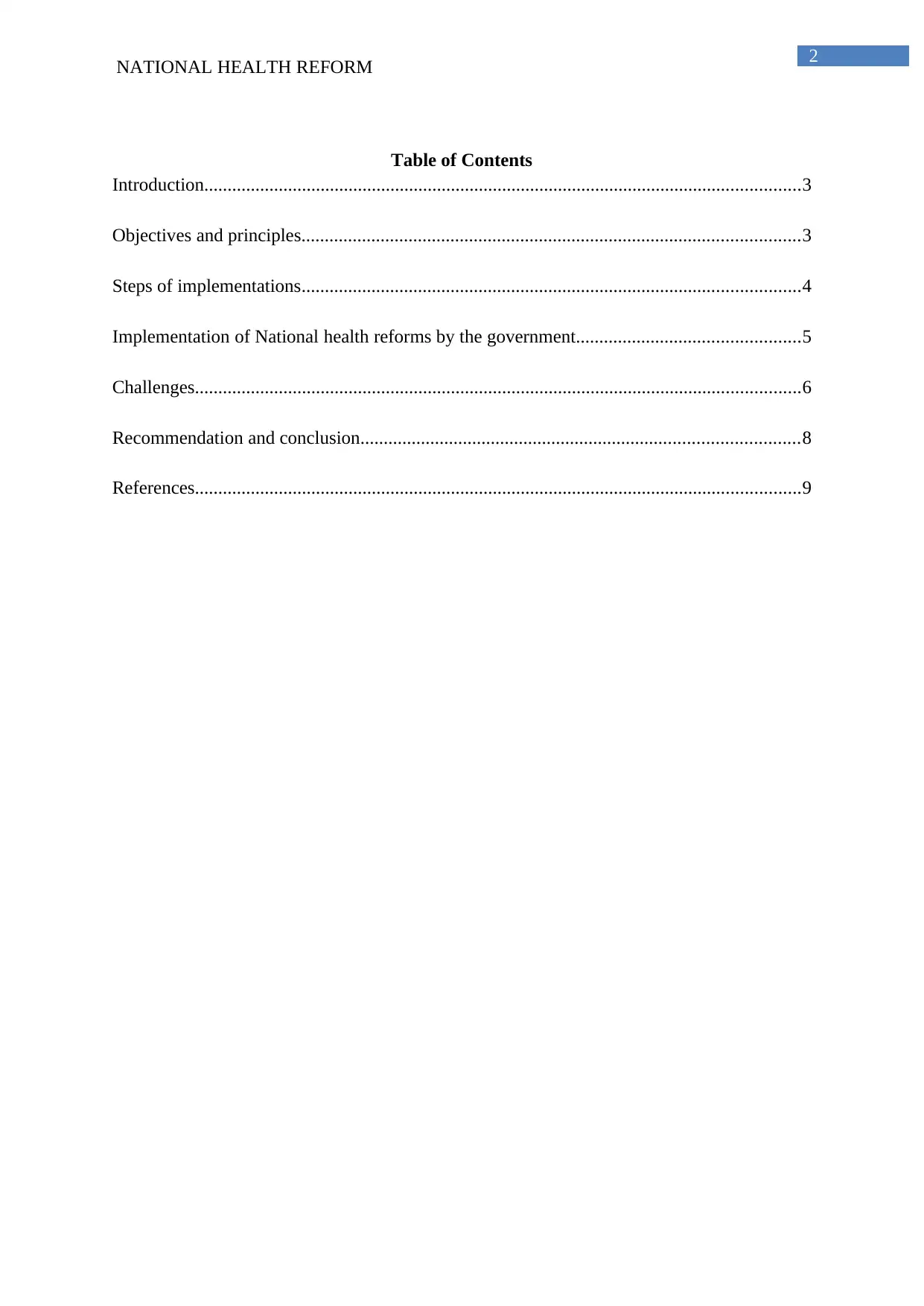
2
NATIONAL HEALTH REFORM
Table of Contents
Introduction................................................................................................................................3
Objectives and principles...........................................................................................................3
Steps of implementations...........................................................................................................4
Implementation of National health reforms by the government................................................5
Challenges..................................................................................................................................6
Recommendation and conclusion..............................................................................................8
References..................................................................................................................................9
NATIONAL HEALTH REFORM
Table of Contents
Introduction................................................................................................................................3
Objectives and principles...........................................................................................................3
Steps of implementations...........................................................................................................4
Implementation of National health reforms by the government................................................5
Challenges..................................................................................................................................6
Recommendation and conclusion..............................................................................................8
References..................................................................................................................................9
⊘ This is a preview!⊘
Do you want full access?
Subscribe today to unlock all pages.

Trusted by 1+ million students worldwide
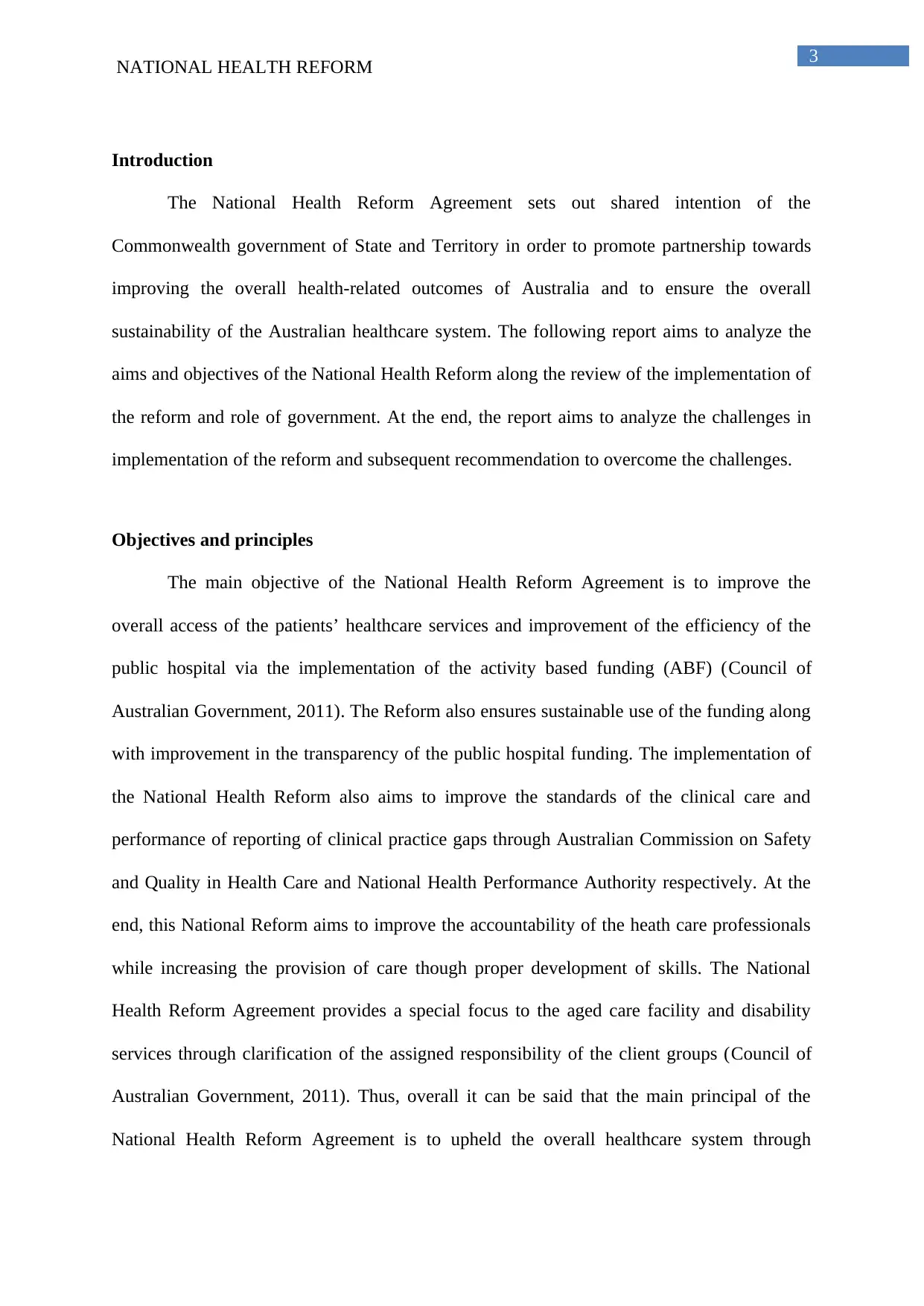
3
NATIONAL HEALTH REFORM
Introduction
The National Health Reform Agreement sets out shared intention of the
Commonwealth government of State and Territory in order to promote partnership towards
improving the overall health-related outcomes of Australia and to ensure the overall
sustainability of the Australian healthcare system. The following report aims to analyze the
aims and objectives of the National Health Reform along the review of the implementation of
the reform and role of government. At the end, the report aims to analyze the challenges in
implementation of the reform and subsequent recommendation to overcome the challenges.
Objectives and principles
The main objective of the National Health Reform Agreement is to improve the
overall access of the patients’ healthcare services and improvement of the efficiency of the
public hospital via the implementation of the activity based funding (ABF) (Council of
Australian Government, 2011). The Reform also ensures sustainable use of the funding along
with improvement in the transparency of the public hospital funding. The implementation of
the National Health Reform also aims to improve the standards of the clinical care and
performance of reporting of clinical practice gaps through Australian Commission on Safety
and Quality in Health Care and National Health Performance Authority respectively. At the
end, this National Reform aims to improve the accountability of the heath care professionals
while increasing the provision of care though proper development of skills. The National
Health Reform Agreement provides a special focus to the aged care facility and disability
services through clarification of the assigned responsibility of the client groups (Council of
Australian Government, 2011). Thus, overall it can be said that the main principal of the
National Health Reform Agreement is to upheld the overall healthcare system through
NATIONAL HEALTH REFORM
Introduction
The National Health Reform Agreement sets out shared intention of the
Commonwealth government of State and Territory in order to promote partnership towards
improving the overall health-related outcomes of Australia and to ensure the overall
sustainability of the Australian healthcare system. The following report aims to analyze the
aims and objectives of the National Health Reform along the review of the implementation of
the reform and role of government. At the end, the report aims to analyze the challenges in
implementation of the reform and subsequent recommendation to overcome the challenges.
Objectives and principles
The main objective of the National Health Reform Agreement is to improve the
overall access of the patients’ healthcare services and improvement of the efficiency of the
public hospital via the implementation of the activity based funding (ABF) (Council of
Australian Government, 2011). The Reform also ensures sustainable use of the funding along
with improvement in the transparency of the public hospital funding. The implementation of
the National Health Reform also aims to improve the standards of the clinical care and
performance of reporting of clinical practice gaps through Australian Commission on Safety
and Quality in Health Care and National Health Performance Authority respectively. At the
end, this National Reform aims to improve the accountability of the heath care professionals
while increasing the provision of care though proper development of skills. The National
Health Reform Agreement provides a special focus to the aged care facility and disability
services through clarification of the assigned responsibility of the client groups (Council of
Australian Government, 2011). Thus, overall it can be said that the main principal of the
National Health Reform Agreement is to upheld the overall healthcare system through
Paraphrase This Document
Need a fresh take? Get an instant paraphrase of this document with our AI Paraphraser
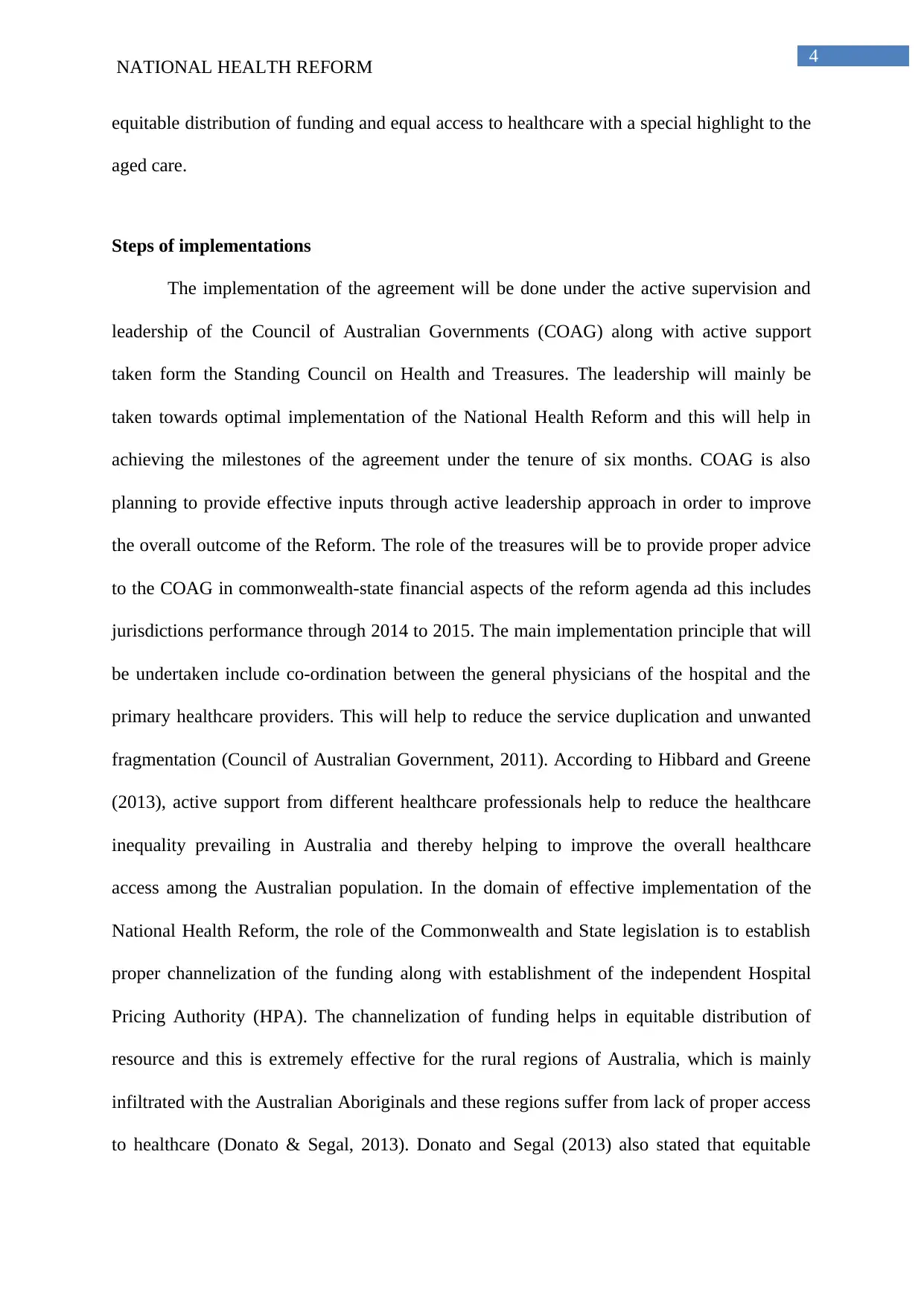
4
NATIONAL HEALTH REFORM
equitable distribution of funding and equal access to healthcare with a special highlight to the
aged care.
Steps of implementations
The implementation of the agreement will be done under the active supervision and
leadership of the Council of Australian Governments (COAG) along with active support
taken form the Standing Council on Health and Treasures. The leadership will mainly be
taken towards optimal implementation of the National Health Reform and this will help in
achieving the milestones of the agreement under the tenure of six months. COAG is also
planning to provide effective inputs through active leadership approach in order to improve
the overall outcome of the Reform. The role of the treasures will be to provide proper advice
to the COAG in commonwealth-state financial aspects of the reform agenda ad this includes
jurisdictions performance through 2014 to 2015. The main implementation principle that will
be undertaken include co-ordination between the general physicians of the hospital and the
primary healthcare providers. This will help to reduce the service duplication and unwanted
fragmentation (Council of Australian Government, 2011). According to Hibbard and Greene
(2013), active support from different healthcare professionals help to reduce the healthcare
inequality prevailing in Australia and thereby helping to improve the overall healthcare
access among the Australian population. In the domain of effective implementation of the
National Health Reform, the role of the Commonwealth and State legislation is to establish
proper channelization of the funding along with establishment of the independent Hospital
Pricing Authority (HPA). The channelization of funding helps in equitable distribution of
resource and this is extremely effective for the rural regions of Australia, which is mainly
infiltrated with the Australian Aboriginals and these regions suffer from lack of proper access
to healthcare (Donato & Segal, 2013). Donato and Segal (2013) also stated that equitable
NATIONAL HEALTH REFORM
equitable distribution of funding and equal access to healthcare with a special highlight to the
aged care.
Steps of implementations
The implementation of the agreement will be done under the active supervision and
leadership of the Council of Australian Governments (COAG) along with active support
taken form the Standing Council on Health and Treasures. The leadership will mainly be
taken towards optimal implementation of the National Health Reform and this will help in
achieving the milestones of the agreement under the tenure of six months. COAG is also
planning to provide effective inputs through active leadership approach in order to improve
the overall outcome of the Reform. The role of the treasures will be to provide proper advice
to the COAG in commonwealth-state financial aspects of the reform agenda ad this includes
jurisdictions performance through 2014 to 2015. The main implementation principle that will
be undertaken include co-ordination between the general physicians of the hospital and the
primary healthcare providers. This will help to reduce the service duplication and unwanted
fragmentation (Council of Australian Government, 2011). According to Hibbard and Greene
(2013), active support from different healthcare professionals help to reduce the healthcare
inequality prevailing in Australia and thereby helping to improve the overall healthcare
access among the Australian population. In the domain of effective implementation of the
National Health Reform, the role of the Commonwealth and State legislation is to establish
proper channelization of the funding along with establishment of the independent Hospital
Pricing Authority (HPA). The channelization of funding helps in equitable distribution of
resource and this is extremely effective for the rural regions of Australia, which is mainly
infiltrated with the Australian Aboriginals and these regions suffer from lack of proper access
to healthcare (Donato & Segal, 2013). Donato and Segal (2013) also stated that equitable
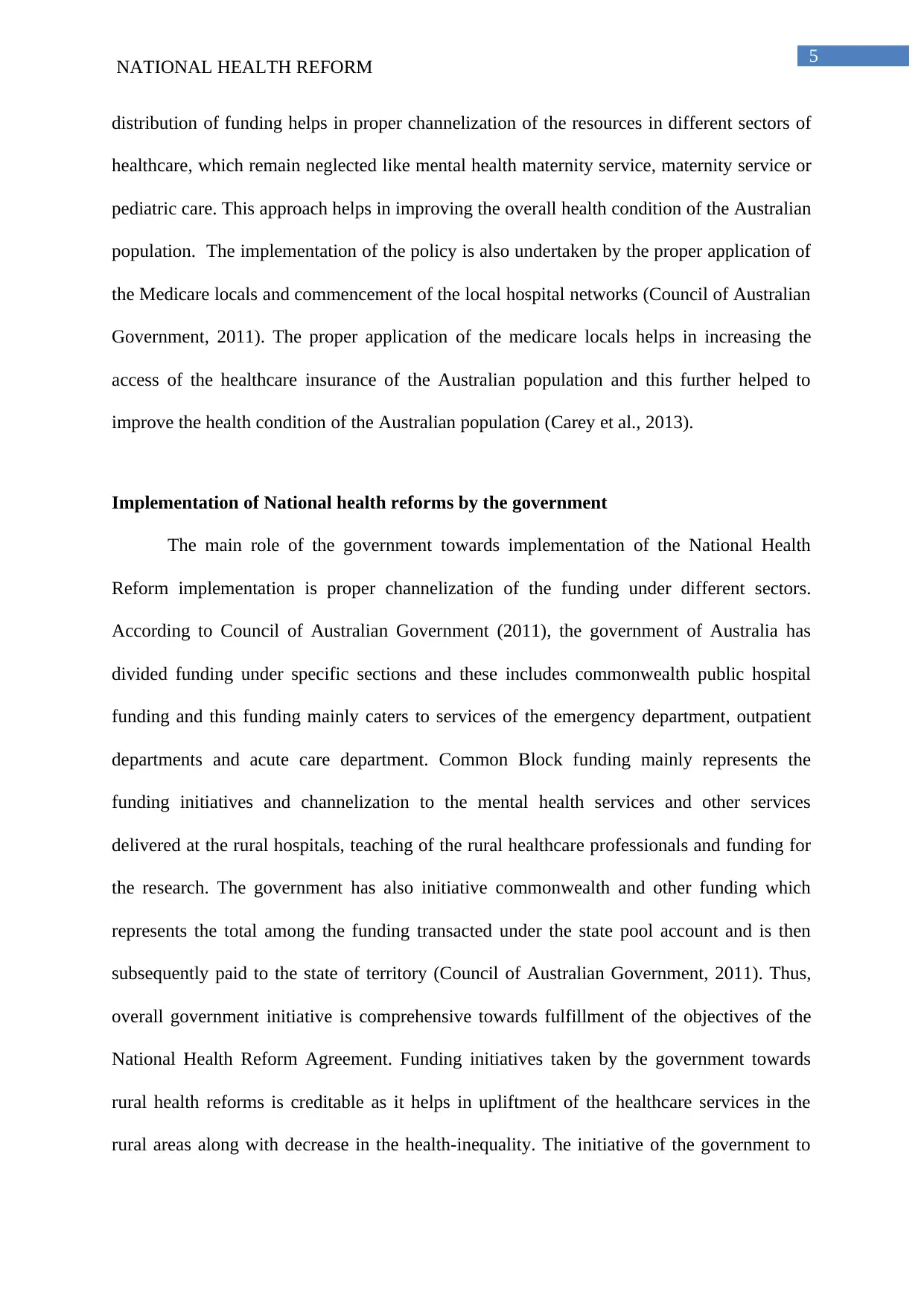
5
NATIONAL HEALTH REFORM
distribution of funding helps in proper channelization of the resources in different sectors of
healthcare, which remain neglected like mental health maternity service, maternity service or
pediatric care. This approach helps in improving the overall health condition of the Australian
population. The implementation of the policy is also undertaken by the proper application of
the Medicare locals and commencement of the local hospital networks (Council of Australian
Government, 2011). The proper application of the medicare locals helps in increasing the
access of the healthcare insurance of the Australian population and this further helped to
improve the health condition of the Australian population (Carey et al., 2013).
Implementation of National health reforms by the government
The main role of the government towards implementation of the National Health
Reform implementation is proper channelization of the funding under different sectors.
According to Council of Australian Government (2011), the government of Australia has
divided funding under specific sections and these includes commonwealth public hospital
funding and this funding mainly caters to services of the emergency department, outpatient
departments and acute care department. Common Block funding mainly represents the
funding initiatives and channelization to the mental health services and other services
delivered at the rural hospitals, teaching of the rural healthcare professionals and funding for
the research. The government has also initiative commonwealth and other funding which
represents the total among the funding transacted under the state pool account and is then
subsequently paid to the state of territory (Council of Australian Government, 2011). Thus,
overall government initiative is comprehensive towards fulfillment of the objectives of the
National Health Reform Agreement. Funding initiatives taken by the government towards
rural health reforms is creditable as it helps in upliftment of the healthcare services in the
rural areas along with decrease in the health-inequality. The initiative of the government to
NATIONAL HEALTH REFORM
distribution of funding helps in proper channelization of the resources in different sectors of
healthcare, which remain neglected like mental health maternity service, maternity service or
pediatric care. This approach helps in improving the overall health condition of the Australian
population. The implementation of the policy is also undertaken by the proper application of
the Medicare locals and commencement of the local hospital networks (Council of Australian
Government, 2011). The proper application of the medicare locals helps in increasing the
access of the healthcare insurance of the Australian population and this further helped to
improve the health condition of the Australian population (Carey et al., 2013).
Implementation of National health reforms by the government
The main role of the government towards implementation of the National Health
Reform implementation is proper channelization of the funding under different sectors.
According to Council of Australian Government (2011), the government of Australia has
divided funding under specific sections and these includes commonwealth public hospital
funding and this funding mainly caters to services of the emergency department, outpatient
departments and acute care department. Common Block funding mainly represents the
funding initiatives and channelization to the mental health services and other services
delivered at the rural hospitals, teaching of the rural healthcare professionals and funding for
the research. The government has also initiative commonwealth and other funding which
represents the total among the funding transacted under the state pool account and is then
subsequently paid to the state of territory (Council of Australian Government, 2011). Thus,
overall government initiative is comprehensive towards fulfillment of the objectives of the
National Health Reform Agreement. Funding initiatives taken by the government towards
rural health reforms is creditable as it helps in upliftment of the healthcare services in the
rural areas along with decrease in the health-inequality. The initiative of the government to
⊘ This is a preview!⊘
Do you want full access?
Subscribe today to unlock all pages.

Trusted by 1+ million students worldwide
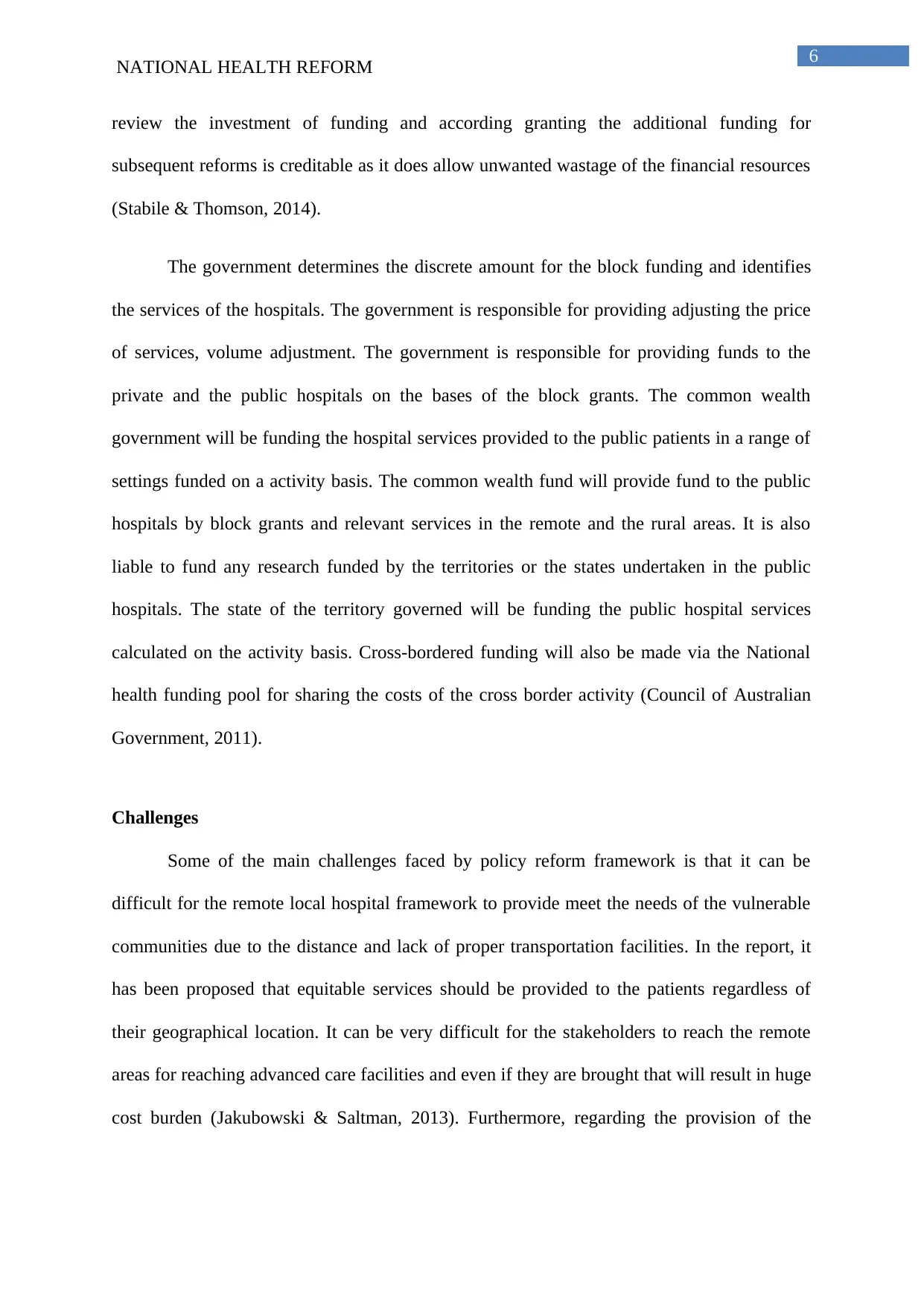
6
NATIONAL HEALTH REFORM
review the investment of funding and according granting the additional funding for
subsequent reforms is creditable as it does allow unwanted wastage of the financial resources
(Stabile & Thomson, 2014).
The government determines the discrete amount for the block funding and identifies
the services of the hospitals. The government is responsible for providing adjusting the price
of services, volume adjustment. The government is responsible for providing funds to the
private and the public hospitals on the bases of the block grants. The common wealth
government will be funding the hospital services provided to the public patients in a range of
settings funded on a activity basis. The common wealth fund will provide fund to the public
hospitals by block grants and relevant services in the remote and the rural areas. It is also
liable to fund any research funded by the territories or the states undertaken in the public
hospitals. The state of the territory governed will be funding the public hospital services
calculated on the activity basis. Cross-bordered funding will also be made via the National
health funding pool for sharing the costs of the cross border activity (Council of Australian
Government, 2011).
Challenges
Some of the main challenges faced by policy reform framework is that it can be
difficult for the remote local hospital framework to provide meet the needs of the vulnerable
communities due to the distance and lack of proper transportation facilities. In the report, it
has been proposed that equitable services should be provided to the patients regardless of
their geographical location. It can be very difficult for the stakeholders to reach the remote
areas for reaching advanced care facilities and even if they are brought that will result in huge
cost burden (Jakubowski & Saltman, 2013). Furthermore, regarding the provision of the
NATIONAL HEALTH REFORM
review the investment of funding and according granting the additional funding for
subsequent reforms is creditable as it does allow unwanted wastage of the financial resources
(Stabile & Thomson, 2014).
The government determines the discrete amount for the block funding and identifies
the services of the hospitals. The government is responsible for providing adjusting the price
of services, volume adjustment. The government is responsible for providing funds to the
private and the public hospitals on the bases of the block grants. The common wealth
government will be funding the hospital services provided to the public patients in a range of
settings funded on a activity basis. The common wealth fund will provide fund to the public
hospitals by block grants and relevant services in the remote and the rural areas. It is also
liable to fund any research funded by the territories or the states undertaken in the public
hospitals. The state of the territory governed will be funding the public hospital services
calculated on the activity basis. Cross-bordered funding will also be made via the National
health funding pool for sharing the costs of the cross border activity (Council of Australian
Government, 2011).
Challenges
Some of the main challenges faced by policy reform framework is that it can be
difficult for the remote local hospital framework to provide meet the needs of the vulnerable
communities due to the distance and lack of proper transportation facilities. In the report, it
has been proposed that equitable services should be provided to the patients regardless of
their geographical location. It can be very difficult for the stakeholders to reach the remote
areas for reaching advanced care facilities and even if they are brought that will result in huge
cost burden (Jakubowski & Saltman, 2013). Furthermore, regarding the provision of the
Paraphrase This Document
Need a fresh take? Get an instant paraphrase of this document with our AI Paraphraser
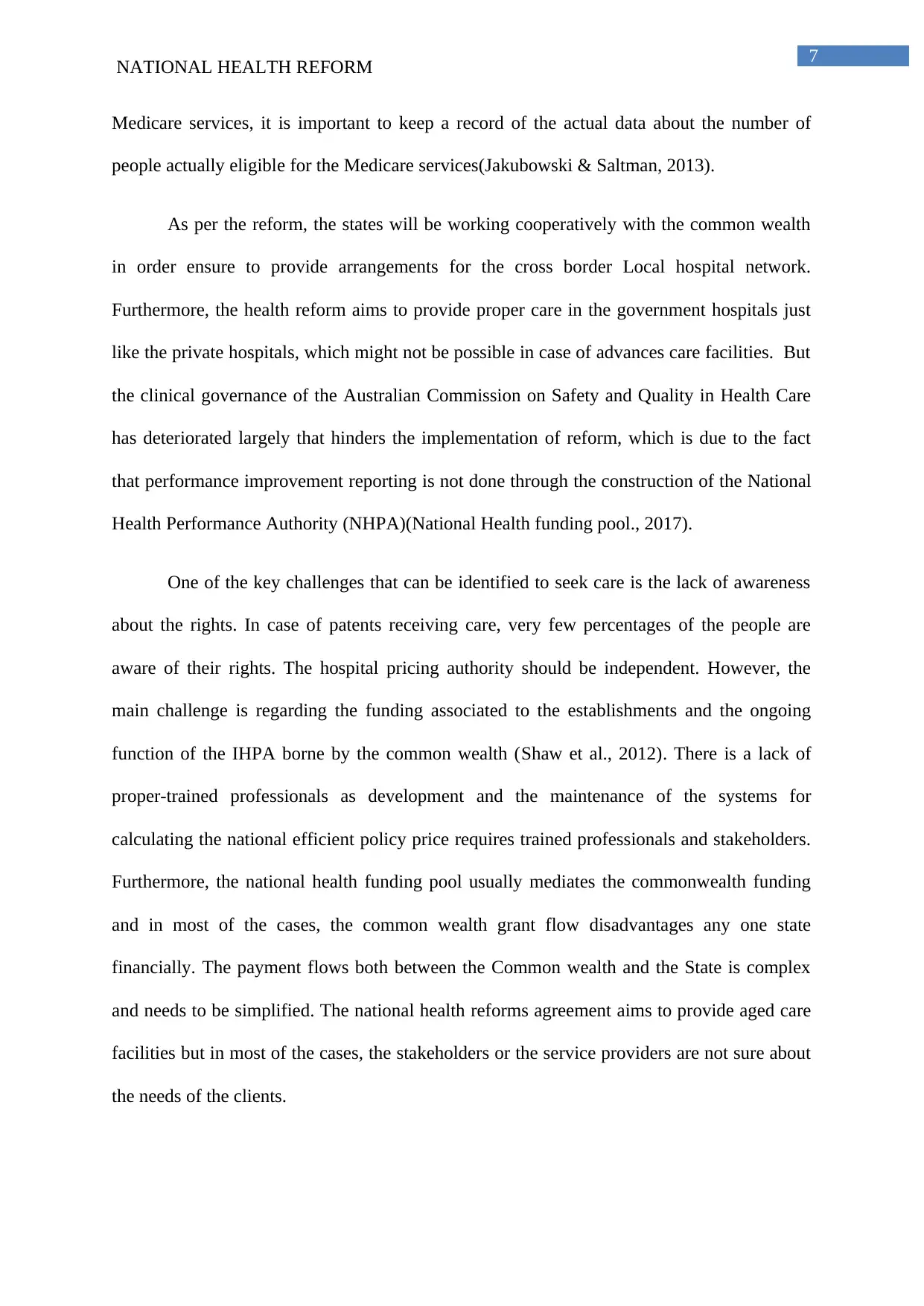
7
NATIONAL HEALTH REFORM
Medicare services, it is important to keep a record of the actual data about the number of
people actually eligible for the Medicare services(Jakubowski & Saltman, 2013).
As per the reform, the states will be working cooperatively with the common wealth
in order ensure to provide arrangements for the cross border Local hospital network.
Furthermore, the health reform aims to provide proper care in the government hospitals just
like the private hospitals, which might not be possible in case of advances care facilities. But
the clinical governance of the Australian Commission on Safety and Quality in Health Care
has deteriorated largely that hinders the implementation of reform, which is due to the fact
that performance improvement reporting is not done through the construction of the National
Health Performance Authority (NHPA)(National Health funding pool., 2017).
One of the key challenges that can be identified to seek care is the lack of awareness
about the rights. In case of patents receiving care, very few percentages of the people are
aware of their rights. The hospital pricing authority should be independent. However, the
main challenge is regarding the funding associated to the establishments and the ongoing
function of the IHPA borne by the common wealth (Shaw et al., 2012). There is a lack of
proper-trained professionals as development and the maintenance of the systems for
calculating the national efficient policy price requires trained professionals and stakeholders.
Furthermore, the national health funding pool usually mediates the commonwealth funding
and in most of the cases, the common wealth grant flow disadvantages any one state
financially. The payment flows both between the Common wealth and the State is complex
and needs to be simplified. The national health reforms agreement aims to provide aged care
facilities but in most of the cases, the stakeholders or the service providers are not sure about
the needs of the clients.
NATIONAL HEALTH REFORM
Medicare services, it is important to keep a record of the actual data about the number of
people actually eligible for the Medicare services(Jakubowski & Saltman, 2013).
As per the reform, the states will be working cooperatively with the common wealth
in order ensure to provide arrangements for the cross border Local hospital network.
Furthermore, the health reform aims to provide proper care in the government hospitals just
like the private hospitals, which might not be possible in case of advances care facilities. But
the clinical governance of the Australian Commission on Safety and Quality in Health Care
has deteriorated largely that hinders the implementation of reform, which is due to the fact
that performance improvement reporting is not done through the construction of the National
Health Performance Authority (NHPA)(National Health funding pool., 2017).
One of the key challenges that can be identified to seek care is the lack of awareness
about the rights. In case of patents receiving care, very few percentages of the people are
aware of their rights. The hospital pricing authority should be independent. However, the
main challenge is regarding the funding associated to the establishments and the ongoing
function of the IHPA borne by the common wealth (Shaw et al., 2012). There is a lack of
proper-trained professionals as development and the maintenance of the systems for
calculating the national efficient policy price requires trained professionals and stakeholders.
Furthermore, the national health funding pool usually mediates the commonwealth funding
and in most of the cases, the common wealth grant flow disadvantages any one state
financially. The payment flows both between the Common wealth and the State is complex
and needs to be simplified. The national health reforms agreement aims to provide aged care
facilities but in most of the cases, the stakeholders or the service providers are not sure about
the needs of the clients.
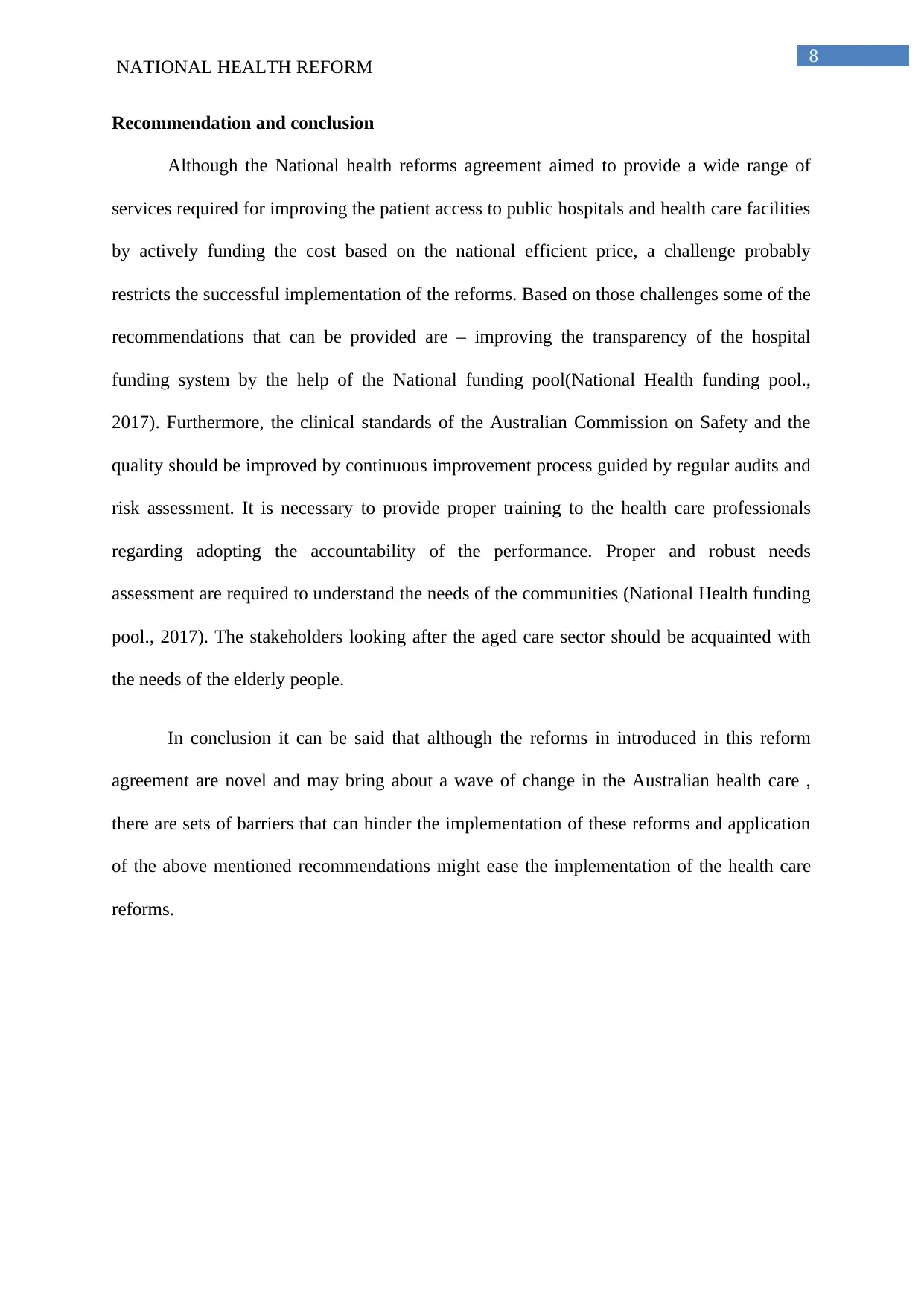
8
NATIONAL HEALTH REFORM
Recommendation and conclusion
Although the National health reforms agreement aimed to provide a wide range of
services required for improving the patient access to public hospitals and health care facilities
by actively funding the cost based on the national efficient price, a challenge probably
restricts the successful implementation of the reforms. Based on those challenges some of the
recommendations that can be provided are – improving the transparency of the hospital
funding system by the help of the National funding pool(National Health funding pool.,
2017). Furthermore, the clinical standards of the Australian Commission on Safety and the
quality should be improved by continuous improvement process guided by regular audits and
risk assessment. It is necessary to provide proper training to the health care professionals
regarding adopting the accountability of the performance. Proper and robust needs
assessment are required to understand the needs of the communities (National Health funding
pool., 2017). The stakeholders looking after the aged care sector should be acquainted with
the needs of the elderly people.
In conclusion it can be said that although the reforms in introduced in this reform
agreement are novel and may bring about a wave of change in the Australian health care ,
there are sets of barriers that can hinder the implementation of these reforms and application
of the above mentioned recommendations might ease the implementation of the health care
reforms.
NATIONAL HEALTH REFORM
Recommendation and conclusion
Although the National health reforms agreement aimed to provide a wide range of
services required for improving the patient access to public hospitals and health care facilities
by actively funding the cost based on the national efficient price, a challenge probably
restricts the successful implementation of the reforms. Based on those challenges some of the
recommendations that can be provided are – improving the transparency of the hospital
funding system by the help of the National funding pool(National Health funding pool.,
2017). Furthermore, the clinical standards of the Australian Commission on Safety and the
quality should be improved by continuous improvement process guided by regular audits and
risk assessment. It is necessary to provide proper training to the health care professionals
regarding adopting the accountability of the performance. Proper and robust needs
assessment are required to understand the needs of the communities (National Health funding
pool., 2017). The stakeholders looking after the aged care sector should be acquainted with
the needs of the elderly people.
In conclusion it can be said that although the reforms in introduced in this reform
agreement are novel and may bring about a wave of change in the Australian health care ,
there are sets of barriers that can hinder the implementation of these reforms and application
of the above mentioned recommendations might ease the implementation of the health care
reforms.
⊘ This is a preview!⊘
Do you want full access?
Subscribe today to unlock all pages.

Trusted by 1+ million students worldwide
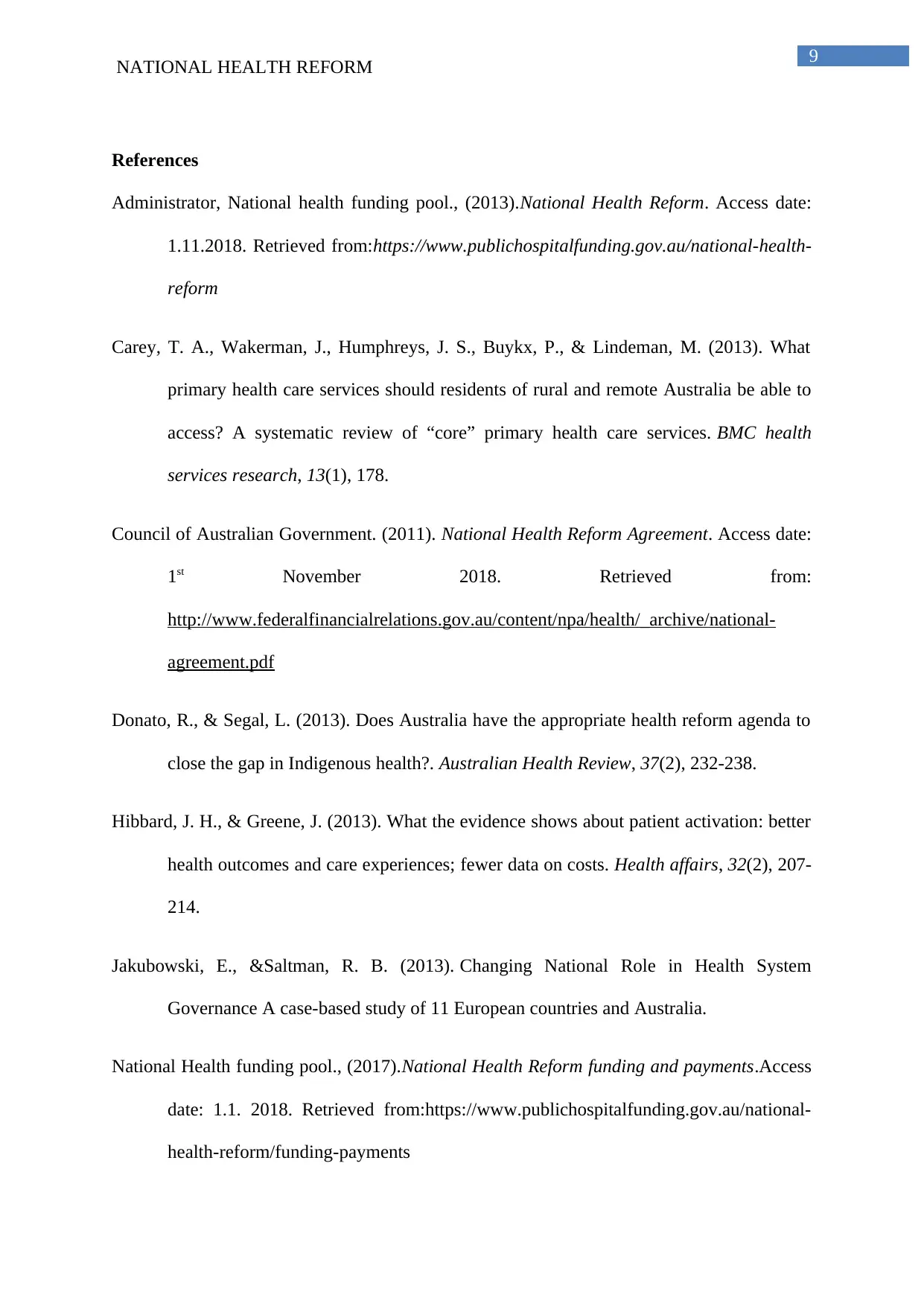
9
NATIONAL HEALTH REFORM
References
Administrator, National health funding pool., (2013).National Health Reform. Access date:
1.11.2018. Retrieved from:https://www.publichospitalfunding.gov.au/national-health-
reform
Carey, T. A., Wakerman, J., Humphreys, J. S., Buykx, P., & Lindeman, M. (2013). What
primary health care services should residents of rural and remote Australia be able to
access? A systematic review of “core” primary health care services. BMC health
services research, 13(1), 178.
Council of Australian Government. (2011). National Health Reform Agreement. Access date:
1st November 2018. Retrieved from:
http://www.federalfinancialrelations.gov.au/content/npa/health/_archive/national-
agreement.pdf
Donato, R., & Segal, L. (2013). Does Australia have the appropriate health reform agenda to
close the gap in Indigenous health?. Australian Health Review, 37(2), 232-238.
Hibbard, J. H., & Greene, J. (2013). What the evidence shows about patient activation: better
health outcomes and care experiences; fewer data on costs. Health affairs, 32(2), 207-
214.
Jakubowski, E., &Saltman, R. B. (2013). Changing National Role in Health System
Governance A case-based study of 11 European countries and Australia.
National Health funding pool., (2017).National Health Reform funding and payments.Access
date: 1.1. 2018. Retrieved from:https://www.publichospitalfunding.gov.au/national-
health-reform/funding-payments
NATIONAL HEALTH REFORM
References
Administrator, National health funding pool., (2013).National Health Reform. Access date:
1.11.2018. Retrieved from:https://www.publichospitalfunding.gov.au/national-health-
reform
Carey, T. A., Wakerman, J., Humphreys, J. S., Buykx, P., & Lindeman, M. (2013). What
primary health care services should residents of rural and remote Australia be able to
access? A systematic review of “core” primary health care services. BMC health
services research, 13(1), 178.
Council of Australian Government. (2011). National Health Reform Agreement. Access date:
1st November 2018. Retrieved from:
http://www.federalfinancialrelations.gov.au/content/npa/health/_archive/national-
agreement.pdf
Donato, R., & Segal, L. (2013). Does Australia have the appropriate health reform agenda to
close the gap in Indigenous health?. Australian Health Review, 37(2), 232-238.
Hibbard, J. H., & Greene, J. (2013). What the evidence shows about patient activation: better
health outcomes and care experiences; fewer data on costs. Health affairs, 32(2), 207-
214.
Jakubowski, E., &Saltman, R. B. (2013). Changing National Role in Health System
Governance A case-based study of 11 European countries and Australia.
National Health funding pool., (2017).National Health Reform funding and payments.Access
date: 1.1. 2018. Retrieved from:https://www.publichospitalfunding.gov.au/national-
health-reform/funding-payments
Paraphrase This Document
Need a fresh take? Get an instant paraphrase of this document with our AI Paraphraser
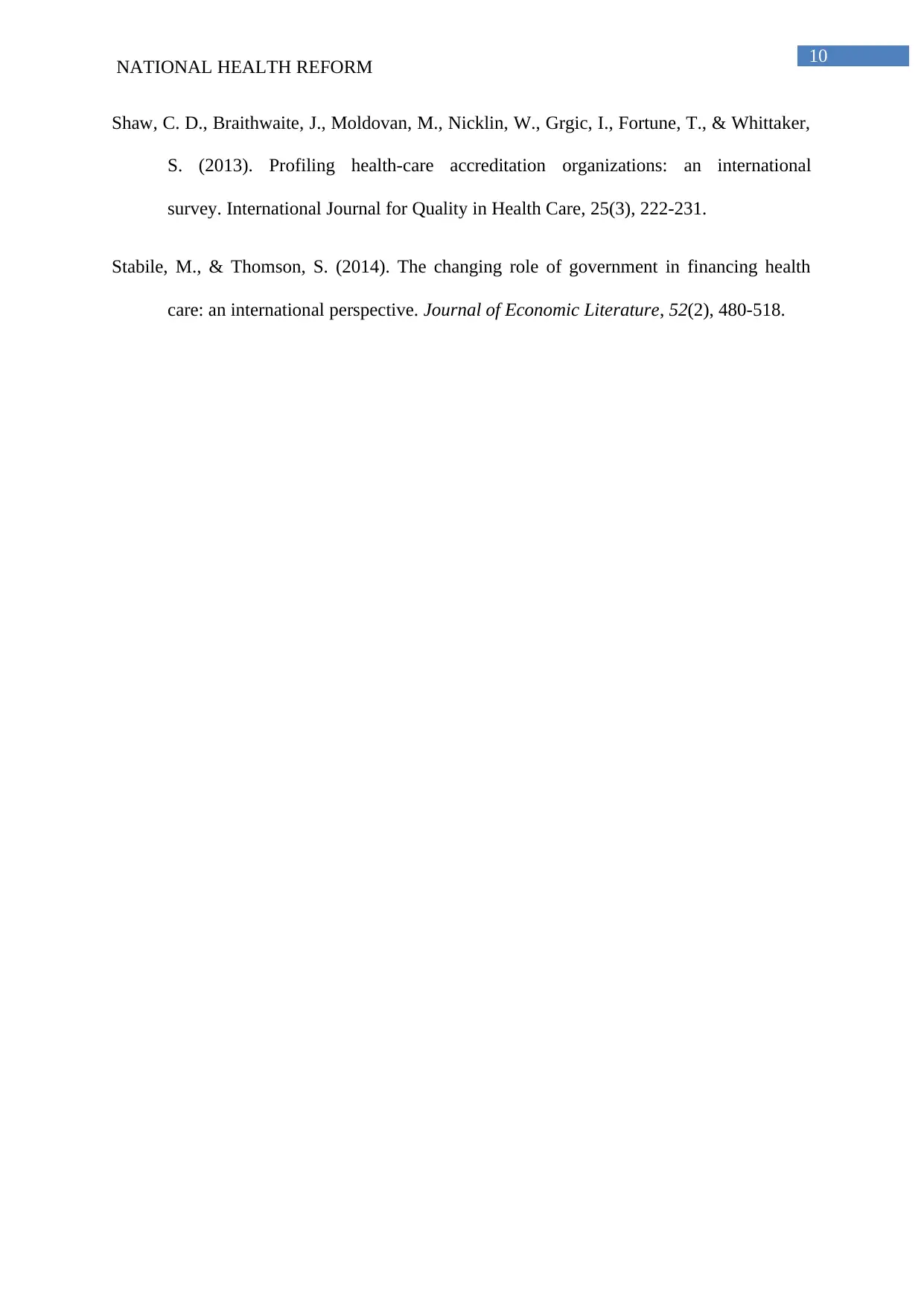
10
NATIONAL HEALTH REFORM
Shaw, C. D., Braithwaite, J., Moldovan, M., Nicklin, W., Grgic, I., Fortune, T., & Whittaker,
S. (2013). Profiling health-care accreditation organizations: an international
survey. International Journal for Quality in Health Care, 25(3), 222-231.
Stabile, M., & Thomson, S. (2014). The changing role of government in financing health
care: an international perspective. Journal of Economic Literature, 52(2), 480-518.
NATIONAL HEALTH REFORM
Shaw, C. D., Braithwaite, J., Moldovan, M., Nicklin, W., Grgic, I., Fortune, T., & Whittaker,
S. (2013). Profiling health-care accreditation organizations: an international
survey. International Journal for Quality in Health Care, 25(3), 222-231.
Stabile, M., & Thomson, S. (2014). The changing role of government in financing health
care: an international perspective. Journal of Economic Literature, 52(2), 480-518.
1 out of 11
Related Documents
Your All-in-One AI-Powered Toolkit for Academic Success.
+13062052269
info@desklib.com
Available 24*7 on WhatsApp / Email
![[object Object]](/_next/static/media/star-bottom.7253800d.svg)
Unlock your academic potential
Copyright © 2020–2025 A2Z Services. All Rights Reserved. Developed and managed by ZUCOL.





